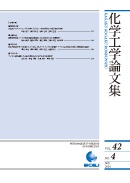
- Issue 6 Pages 187-
- Issue 5 Pages 161-
- Issue 4 Pages 137-
- Issue 3 Pages 83-
- Issue 2 Pages 37-
- Issue 1 Pages 1-
- |<
- <
- 1
- >
- >|
-
2016 Volume 42 Issue 4 Pages edit_4
Published: July 20, 2016
Released on J-STAGE: July 20, 2016
JOURNAL RESTRICTED ACCESSDownload PDF (205K)
-
Shuji Matsusaka, Atsushi Noguchi, Shiro Kitajima, Masatoshi YasudaArticle type: Research Paper
2016 Volume 42 Issue 4 Pages 137-141
Published: July 20, 2016
Released on J-STAGE: July 20, 2016
JOURNAL RESTRICTED ACCESSExperiments were carried out on the electric charging of particles in a powder bed with positive ions and/or electrons, which were generated by an atmospheric pressure plasma jet. Here, the effective electric charging area was set to be approximately 0.01 m2 by supplying 1 SLM (standard liter per minute) of helium gas. The upper layer particles of a dielectric powder bed (PTFE) reached equilibrium charging after a few seconds, while the lower layer particles were gradually charged, and the particle charge approached the equilibrium value in 1 min. It was found that the charges migrated up to a depth of 2 mm in the powder bed, and the lower layer particles had larger equilibrium charges than the upper layer ones. In addition, it was found that charging is difficult for particles that do not have very high electrical resistivity (manganese ferrite). However, the lowest layer particles could be charged by placing a dielectric plate under the powder bed.
View full abstractDownload PDF (721K)
-
Yasunari Nemoto, Yoshihiro Iitsuka, Katsuya Watanabe, Yoshimasa Amano, ...Article type: Research Paper
2016 Volume 42 Issue 4 Pages 142-147
Published: July 20, 2016
Released on J-STAGE: July 20, 2016
JOURNAL RESTRICTED ACCESSActivated carbons (ACs) were prepared from sulfur-containing petroleum coke (PC, sulfur content 8%) and oxidized to introduce sulfo groups. The effect of specific surface area of ACs on the amount of Ni(II) adsorbed on oxidized ACs was examined. PC was first activated with potassium hydroxide (KOH) at a KOH/PC mass ratio of 1–3, an activation temperature of 400–850°C, and an activation time of 0.5–2.0 h. The specific surface area and total pore volume of the ACs prepared were 510–1,890 m2/g and 0.25–1.07 cm3/g, respectively. In the second step, ACs were oxidized with concentrated nitric acid under the same conditions, and Ni(II) adsorption from water onto oxidized ACs was compared with that onto oxidized commercial bead shaped activated carbon (BAC, sulfur content less than 0.02%). The results showed that Ni(II) adsorption onto oxidized ACs increased linearly with the increase in specific surface area of ACs from 500 to 1,000 m2/g and reached saturation at 3.5 mmol/g in the range of 1,000–1,900 m2/g. Oxidized ACs adsorbed Ni(II) even at low solution pH of 1.0, whereas no adsorption onto oxidized BAC was observed, suggesting that sulfo groups were present on the surface of oxidized AC prepared from sulfur-containing PC.
View full abstractDownload PDF (426K)
-
Takuya Fukumura, Masami Yokota, Mitsumasa Osada, Kazuhisa SatoArticle type: Research Paper
2016 Volume 42 Issue 4 Pages 148-154
Published: July 20, 2016
Released on J-STAGE: July 20, 2016
JOURNAL RESTRICTED ACCESSThe effects of operating factors on the synthesis of sodium lactate from glycerol at high temperature in alkaline aqueous solution were experimentally investigated and a kinetic analysis was conducted. Experiments with glycerol and NaOH as reactants clarified the effects of temperature and initial molar ratio of glycerol to NaOH on the formation of lactate and by-products. Experiments with lactate and NaOH as reactants revealed the dehydration, decaboxylation and C–C cleavage of lactate. Fitting lines based on the kinetic model were in good agreement with the experimental data. Numerical simulations suggested that high selectivity of lactate could be achieved within a short reaction time under conditions of higher initial concentration of glycerol than NaOH at a temperature of 623 K.
View full abstractDownload PDF (925K)
-
Tsuyoshi Yamamoto, Yoshiho Iwama, Ryosuke Imazato, Yusuke AsakumaArticle type: Research Paper
2016 Volume 42 Issue 4 Pages 155-160
Published: July 20, 2016
Released on J-STAGE: July 20, 2016
JOURNAL RESTRICTED ACCESSIn this study, to investigate the effect of combustion enhancement by irradiating microwave power, NO concentrations have been measured in the combustion experiments using premixed CH4/air flame with and without microwave irradiation. Analyses of NO formation using numerical simulation with a detailed kinetic model have been performed to investigate thermal effect and non-thermal effect of microwave for the combustion enhancement by irradiating microwave power. The experimental result shows that NO concentration in case of combustion with microwave superposition is higher than that in case of normal combustion. In particular, when equivalence ratio is less than 1.0 and Zeldovich NO is a dominant formation mechanism, there has a high increasing rate of NO concentration. The simulation result indicates that NO concentration tends to decrease, when the reaction rate is increased as non-thermal effect of microwave. On the other hand, NO concentration tends to increase, when the combustion temperature is increased as thermal effect of microwave. As a consequence, it is suggested that non-thermal effect of microwave is a small and thermal effect of microwave becomes a dominant factor for the combustion enhancement on premixed CH4/air flame with irradiating microwave power.
View full abstractDownload PDF (868K)
- |<
- <
- 1
- >
- >|